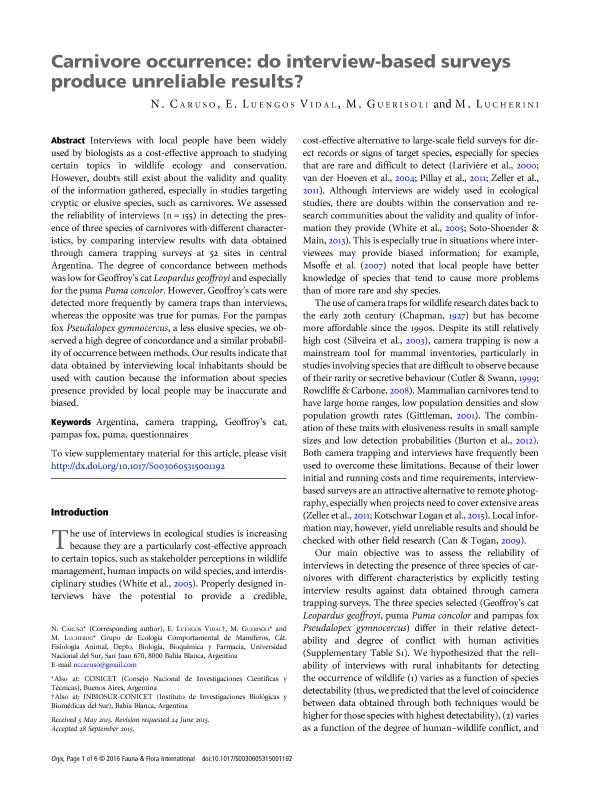Artículo
Carnivore occurrence: do interview-based surveys produce unreliable results?
Fecha de publicación:
25/04/2016
Editorial:
Cambridge University Press
Revista:
Oryx
ISSN:
0030-6053
Idioma:
Inglés
Tipo de recurso:
Artículo publicado
Clasificación temática:
Resumen
Interviews with local people have been widely used by biologists as a cost-effective approach to studying certain topics in wildlife ecology and conservation. However, doubts still exist about the validity and quality of the information gathered, especially in studies targeting cryptic or elusive species, such as carnivores. We assessed the reliability of interviews (n = 155) in detecting the presence of three species of carnivores with different characteristics, by comparing interview results with data obtained through camera trapping surveys at 52 sites in central Argentina. The degree of concordance between methods was low for Geoffroy's cat Leopardus geoffroyi and especially for the puma Puma concolor. However, Geoffroy's cats were detected more frequently by camera traps than interviews, whereas the opposite was true for pumas. For the pampas fox Pseudalopex gymnocercus, a less elusive species, we observed a high degree of concordance and a similar probability of occurrence between methods. Our results indicate that data obtained by interviewing local inhabitants should be used with caution because the information about species presence provided by local people may be inaccurate and biased.
Palabras clave:
ARGENTINA
,
CAMERA TRAPPING
,
GEOFFROY'S CAT
,
PAMPAS FOX
,
PUMA
,
QUESTIONNAIRES
Archivos asociados
Licencia
Identificadores
Colecciones
Articulos(CCT - BAHIA BLANCA)
Articulos de CTRO.CIENTIFICO TECNOL.CONICET - BAHIA BLANCA
Articulos de CTRO.CIENTIFICO TECNOL.CONICET - BAHIA BLANCA
Citación
Caruso, Nicolás; Luengos Vidal, Estela Maris; Guerisoli, Maria de Las Mercedes; Lucherini, Mauro; Carnivore occurrence: do interview-based surveys produce unreliable results?; Cambridge University Press; Oryx; 51; 2; 25-4-2016; 240-245
Compartir
Altmétricas




